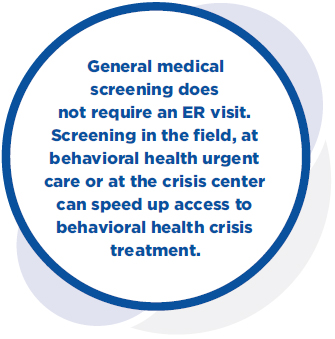The Crisis Roadmap
Crisis Continuum
Values-Based System and Program Design
Measurable Criteria for an Ideal System
Services Address The Continuum of the Crisis Experience
Creating Safe Spaces That Are Warm, Welcoming and Therapeutic
Measurable Criteria for an Ideal Crisis Space
Safety and Security Practices That are Both Safe and Welcoming
Measurable Criteria for Safety and Security Practices That are Both Safe and Welcoming in an Idea System
Treat Law Enforcement as a Preferred Customer
Measurable Criteria for an Idea Crisis Continuum That Treats Law Enforcement as a Preferred Customer
Crisis Center of Crisis Hub
Call Centers and Crisis Lines
Deployed Crisis-trained Police and First Responders
Medical Triage and Screening
Mobile Crisis
Behavioral Health Urgent Care
Intensive Community-based Continuing Crisis Intervention
23-hour Evaluation and Extended Observation
Residential Crisis Program Continuum
Role of Hospitals in Crisis Services
Transportation and Transport
 MEDICAL TRIAGE AND SCREENING
MEDICAL TRIAGE AND SCREENING
In many communities, requirements for medical screening (often called medical clearance) before receiving services from a behavioral health crisis program or being admitted to a behavioral health crisis facility (e.g., residential crisis program, psychiatric inpatient unit) can be excessive (e.g., mandatory urine screens, laboratory testing before being seen) or unavailable (e.g., no medical screening capacity except in an ER) and create significant overuse of medical emergency rooms and barriers to easily accessible behavioral health crisis intervention.
Medical screening guidelines have been established by consensus between the American College of Emergency Physicians and the American Academy of Emergency Psychiatrists. (Lukens, et al., 2006). These guidelines indicate that the purpose of medical screening for individuals experiencing behavioral health crisis is to identify issues that require emergency medical intervention or medical hospitalization, not diagnose or rule out any possible medical condition.
These guidelines further indicate that no routine laboratory tests should be required for medical screening of otherwise physically healthy adults with behavioral health presentations. Decisions about laboratory studies are based on clinical presentation and the judgment of the medical screening practitioner. Additional laboratory studies can be obtained as a courtesy or convenience but should not delay crisis intervention and disposition pending results, which would be subsequently forwarded to the receiving program. If an individual’s medical condition is sufficiently manageable, and they would be discharged home if it weren’t for their behavioral health condition, they should be able to be served in any type of behavioral health crisis service that would make provisions to coordinate further evaluation and intervention for their medical condition.
Using these guidelines, an ideal behavioral health crisis system should establish the ability to facilitate medical screening as much as possible to avoid unnecessary treatment delays and unnecessary ER visits. These services can occur both in-person and through telehealth. An essential component of the continuum of care is for the crisis system to have the capacity in all crisis center settings to routinely triage for emergency medical need and provide routine medical screening examinations as needed without requiring all individuals in behavioral health crisis to go to an ER or medical screening.
Measurable Criteria For An Ideal System
The accountable entity ensures that the crisis hub provider and other crisis providers who receive walk-ins or direct referrals from the community will have the following capacities funded and available:
Routine medical triage
All crisis workers, including first responders and mobile crisis, will be able to triage those medical emergencies that require direct referral to an emergency room and those that do not. Criteria for medical triage by non-medical staff are based on what would commonly require ER evaluation and not on policies and procedures that require ER evaluation of any possible medical risk prior to access to crisis services. Avoidance of unnecessary ER visits is measured as a systemwide and provider-specific quality metric.
Access to medical screening
The crisis hub and other direct access crisis settings will have access to capacity to provide a routine medical screening examination, obtain blood and urine specimens to send to a laboratory and provide immediate medical response for conditions that can be managed in an ambulatory medical office. These services can be provided by crisis center physicians, nurses or by contracted collaboration with a primary care clinic or urgent care center partner. Telehealth can be utilized as appropriate, with crisis staff trained to perform basic tasks, such as obtaining vital signs.
Reimbursement for medical interventions
Unlike in a psychiatric inpatient unit where medical consultations and interventions are part of the all-inclusive rate, other than possible separate physician billing, payment for crisis services at any level of care outside of an ER should be constructed so routine medical screening and intervention can be billed and paid separately. For indigent populations, payment for these services should be coordinated through health services in the community that provide medical care to indigent populations.
Quality indicators
The presence of these structures, processes, activities and results are incorporated into quality indicators and metrics of success for the crisis system as a whole and for individual crisis providers as relevant.

